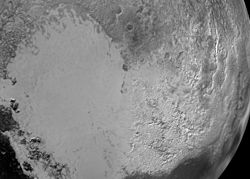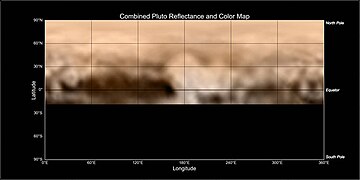Tombaugh Regio
 A detailed view of Tombaugh Regio; a constructed mosaic of monochrome images by New Horizons. | |
| Feature type | Region |
|---|---|
| Location | Anti-Charon hemisphere of Pluto |
| Diameter | 1,590 km (990 mi)[1] |
| Discoverer | New Horizons |
| Eponym | Clyde Tombaugh |
Tombaugh Regio (/ˈtɒmbaʊ ˈrɛdʒioʊ/), sometimes nicknamed "Pluto's heart" after its shape,[2] is the largest bright surface feature of the dwarf planet Pluto.[3][4][5] It lies just north of Pluto's equator, to the northeast of Belton Regio and to the northwest of Safronov Regio, which are both dark features.[6] Its western lobe, a 1,000 km (620 mi)-wide plain of nitrogen and other ices lying within a basin, is named Sputnik Planitia.[7][8] The eastern lobe consists of high-albedo uplands thought to be coated by nitrogen transported through the atmosphere from Sputnik Planitia, and then deposited as ice. Some of this nitrogen ice then returns to Sputnik Planitia via glacial flow. The region is named after Clyde Tombaugh, the discoverer of Pluto.
Description
[edit]Tombaugh Regio is a large, light-colored region about 1,590 km (990 mi) across.[1] The two lobes of the feature are geologically distinct. The western lobe, Sputnik Planitia, is smoother than the eastern, and they are of slightly different colors.[9] Early speculation was that the western lobe may be a large impact crater filled with nitrogen snow. Bright spots within the region were initially speculated to be mountain peaks.[10] Photos, released on 15 July 2015, revealed 3,400 m (11,000 ft) mountains made of water ice in the feature; they also showed no craters in this same region.[11] Subsequent data indicated that the center of Sputnik Planitia is rich in nitrogen, carbon monoxide, and methane ices, and that features near the edges of the region show evidence of ice flow such as glaciers, and light material overlying the darker material at the eastern edge of Belton Regio.[7] The surface of Sputnik Planitia is divided into polygonal convection cells[8] and is less than 10 million years old, indicating that Pluto is geologically active.[12]
The feature had been identified as a bright spot for six decades prior to the New Horizons flyby, although it was impossible to image it with enough resolution to determine its shape. Over these six decades the spot had been observed to be dimming.[13]
In 2020, it was found that Tombaugh Regio controlled the wind circulation of Pluto, and could sculpt the landscape on its surface.[14][15]
Naming and shape
[edit]On 15 July 2015, the region was provisionally named "Tombaugh Regio" by the New Horizons team in honor of astronomer Clyde Tombaugh, the discoverer of Pluto, regio being Latin for "region".[16] On 7 September 2017, the name was officially approved by the International Astronomical Union (IAU), together with names for 13 other surface features on Pluto.[17]
NASA initially referred to the region as a "heart" in reference to its overall shape.[18] Some people find that it also resembles the Disney character Pluto, an animated non-anthropomorphic dog which shares the name of the dwarf planet, in profile facing eastward.[19][20][21] The Walt Disney Company acknowledged this perceived likeness in a short animation.[19][22]
Gallery
[edit]-
A 2010 map of Pluto reconstructed from Hubble Space Telescope data. Although it had not yet been named or identified as a distinct feature, Tombaugh Regio is discernible.
-
The two northern lobes of Tombaugh Regio can be seen to have different compositions in this false-color image
(13 July 2015). -
-
Mosaic of left lobe of Tombaugh Regio, showing the young plain Sputnik Planitia plus mountains to the south (Norgay Montes) and southwest (Hillary Montes), near the east margin of the older, dark cratered terrain of Belton Regio.
-
-
-
Close-up photograph (context) showing polygonal convection cells in the nitrogen ice of Sputnik Planitia, the western lobe of Tombaugh Regio
(14 July 2015).
-
Pluto - map features
(context; 14 July 2015).
See also
[edit]References
[edit] Media related to Tombaugh Regio at Wikimedia Commons
Media related to Tombaugh Regio at Wikimedia Commons
- ^ a b Feltman, Rachel (8 July 2015). "New map of Pluto reveals a 'whale' and a 'donut'". The Washington Post. Archived from the original on 27 May 2019. Retrieved 14 July 2015.
- ^ New Horizons spacecraft displays Pluto's big heart Archived 16 July 2015 at the Wayback Machine. NASA.gov. 14 July 2015. Retrieved 15 July 2015.
- ^ O'Kane, Sean (15 July 2015). "This is the first high resolution image of Pluto's surface". The Verge. Archived from the original on 5 January 2019. Retrieved 15 July 2015.
- ^ Coldewey, Devin (15 July 2015). "Latest New Horizons Photo Shows Close-Up of Pluto's Young Mountains". NBC News. Comcast. Archived from the original on 17 August 2019. Retrieved 15 July 2015.
- ^ The New York Times (15 July 2015). "New Horizons Reveals Ice Mountains on Pluto". The New York Times. Archived from the original on 7 February 2019. Retrieved 15 July 2015.
- ^ McKinnon, Mika (14 July 2015). "Places on Pluto are Being Named for Your Darkest Imaginings". Archived from the original on 22 July 2015. Retrieved 23 July 2015.
- ^ a b "New Horizons Discovers Flowing Ices on Pluto". NASA. 24 July 2015. Archived from the original on 17 March 2016. Retrieved 25 July 2015.
- ^ a b Lakdawalla, Emily (21 December 2015). "Pluto updates from AGU and DPS: Pretty pictures from a confusing world". The Planetary Society. Archived from the original on 24 December 2015. Retrieved 24 January 2016.
- ^ Feltman, Rachel (14 July 2015). "New data reveals that Pluto's heart is broken". The Washington Post. Archived from the original on 15 July 2015. Retrieved 14 July 2015.
- ^ Achenbach, Joel (14 July 2015). "New Horizons reaches Pluto, sees complex terrain with 'great mounds'". The Washington Post. Archived from the original on 14 July 2015. Retrieved 14 July 2015.
- ^ Orwig, Jessica (15 July 2015). "The first insanely close-up photos of Pluto reveal water on its surface". Business Insider. Archived from the original on 9 May 2016. Retrieved 15 July 2015.
- ^ Marchis, F.; Trilling, D. E. (20 January 2016). "The Surface Age of Sputnik Planum, Pluto, Must Be Less than 10 Million Years". PLOS ONE. 11 (1): e0147386. arXiv:1601.02833. Bibcode:2016PLoSO..1147386T. doi:10.1371/journal.pone.0147386. PMC 4720356. PMID 26790001.
- ^ Crockett, Christopher (14 July 2015). "Mission to Pluto: Live coverage: Sitting and speculating". Science News. Archived from the original on 27 May 2016. Retrieved 15 July 2015.
- ^ "Pluto's icy heart controls its wind circulation: NASA study". Deccan Herald. 5 February 2020. Archived from the original on 5 February 2020. Retrieved 5 February 2020.
- ^ Strickland, Ashley (4 February 2020). "When Pluto's frozen heart beats, it creates wind". CNN. Archived from the original on 20 May 2024. Retrieved 5 February 2020.
- ^ Kelly Beatty (2015). "Pluto and Charon Dazzle with Diversity". Popular Mechanics. Archived from the original on 20 July 2015. Retrieved 16 July 2015.
- ^ "Pluto Features Given First Official Names". NASA. 7 September 2017. Archived from the original on 17 September 2017. Retrieved 7 September 2017.
- ^ "NASA's New Horizons: A "Heart" from Pluto as Flyby Begins". NASA. 8 July 2015. Archived from the original on 3 April 2019. Retrieved 15 July 2015.
- ^ a b Westfall, Mike (14 July 2015). "Does Pluto's bright spot look more like a heart or the Disney dog?". Bay News 9. Archived from the original on 16 July 2015. Retrieved 16 July 2015.
- ^ Newcomb, Alyssa (14 July 2015). "New Horizons Space Probe: Pluto Gets the Meme Treatment". ABC News. Archived from the original on 15 July 2015. Retrieved 16 July 2015.
- ^ "The best Pluto memes. Well done, internet". BBC. 15 July 2015. Archived from the original on 18 July 2015. Retrieved 16 July 2015.
- ^ Disney [@Disney] (14 July 2015). "Oh, boy! There's no pup more stellar than Pluto" (Tweet). Retrieved 16 July 2015 – via Twitter.
- ^ Gipson, Lillian (24 July 2015). "New Horizons Discovers Flowing Ices on Pluto". NASA. Archived from the original on 17 March 2016. Retrieved 24 July 2015.






![Hillary Montes and Norgay Montes (14 July 2015).[23]](http://upload.wikimedia.org/wikipedia/commons/thumb/a/ad/NH-Pluto-SputnikPlanum-HillaryMontes-NorgayMontes-20150714.jpg/225px-NH-Pluto-SputnikPlanum-HillaryMontes-NorgayMontes-20150714.jpg)





